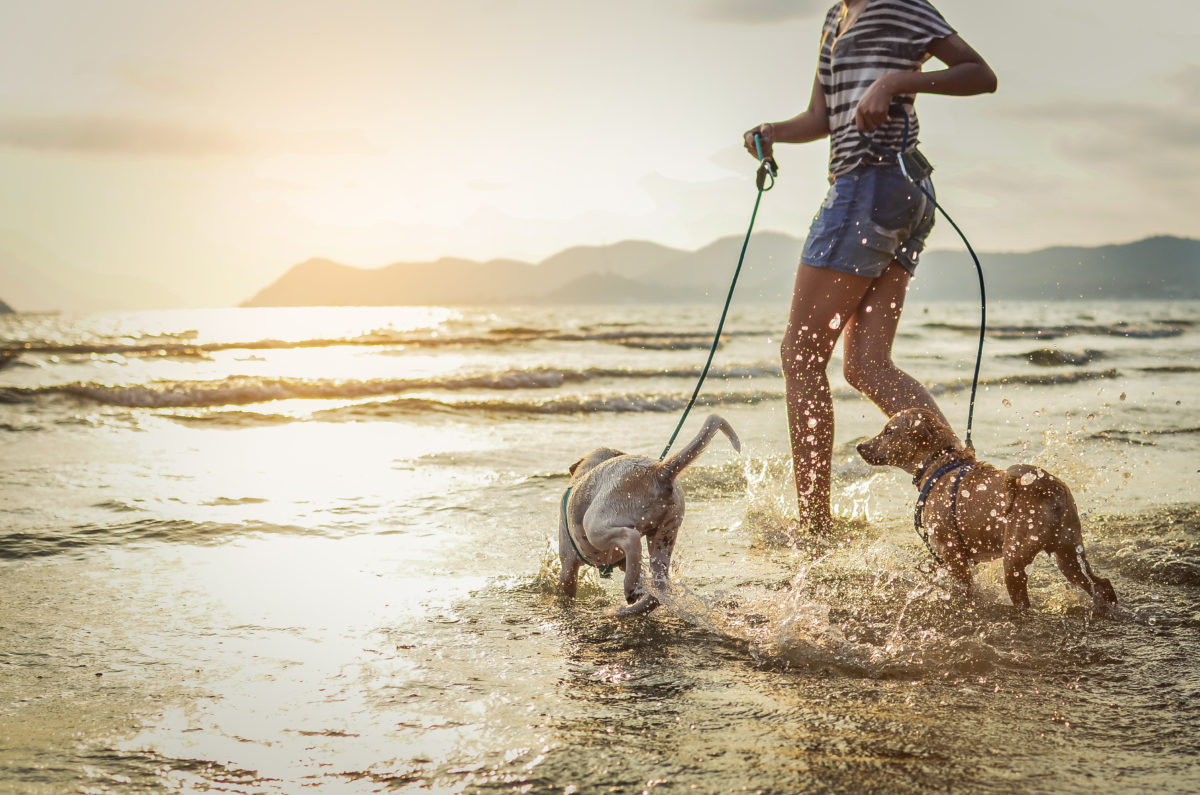Top 6 Dangers For Dogs At The Beach

Whether it’s chasing the sun for a Winter get away or warming up for Summer, the beach is a favourite holiday destination for many of us, including our pets. But, not every dog-friendly beach is without risk. There are a few things that you need to be aware of to help keep your dog safe amongst the fun of sun, sea and sand.
Here are our top six risks to be aware of when taking your dog to the beach:
1. Sun protection
Just like us, our pets can get sunburnt and develop various types of skin cancers. Fortunately, cats and dogs are covered in hair which offers some protection from the sun. So, that gives you the hint – the most likely spots that need some extra sun protection are areas where the haircoat is thin, the top of the nose, ears, tummy and inner thighs. Pets with white hair and pink skin in these areas are most at risk of getting sunburnt.
The best prevention is to use a pet-friendly sunscreen, just in case they decide to lick it, and try to discourage your dog or cat to lie in the sun in the middle of the day. A zinc-based barrier cream like Sudocrem is also a good option. Monitor these higher risk areas of their body for any new spots, lumps or scabs and have them checked by your vet as soon as possible if you do notice any changes.
2. Sea hares
Sea hares are a species of large sea slug that are usually a purplish brown colour and around 30-40cm long. They are found in intertidal rocky shores and seagrass areas in Queensland, New South Wales, Victoria, South Australia and Western Australia. Under certain weather conditions, large numbers can be washed ashore onto beaches and this is when they pose a risk to dogs.
Sea hares are coated in thick slime and will squirt a purple dye if threatened. Both the slime and the purple dye contain toxins, thought to be accumulated in the sea hare from the algae that they eat. Unfortunately, this algal toxin is highly toxic to dogs so even a small lick of a sea hare can lead to signs of toxicity.
Signs include:
- Leg weakness
- Over-excitement
- Tremors/seizures
- Excessive drooling
- Vomiting
- Quickly leading to death
If you see or suspect that your dog has licked or eaten a sea hare, act immediately, don’t wait for signs of intoxication:
- Wipe the slime out of your dog’s mouth and off their tongue with a wet cloth
- If your dog has already developed signs then use a dry cloth to wipe their mouth and tongue, don’t use water as they may choke
- Get to the closest vet as quickly as it is safe to do so, calling them to let them know that you’re on your way
- Sea hare intoxication is treatable if caught early
3. Blue-ringed octopus
It’s hard to believe that the colourful and tiny blue-ringed octopus is one of the most venomous marine animals in the world. Smaller than the palm of your hand, these critters hide out in tide pools, rock pools and coral reefs of the Pacific and Indian Oceans, meaning that they are found most of the way around the east, south and west coasts of Australia. They are quite shy so will only bite if provoked or handled, painlessly envenomating the victim with a tetrodotoxin, produced by bacteria within their salivary glands. Each blue-ringed octopus carries enough tetrodotoxin to kill 26 adult humans so keep a close watch on your dog if they like to play in rockpools.
Tetrodotoxin envenomation acts by causing muscle paralysis within minutes, so signs and death can occur very quickly whilst the victim is still conscious.
** Please be careful as tetrodotoxin is also a risk for humans **
Signs to watch for in dogs include:
- Leg weakness or wobbly walking
- Dilated pupils (the black part in the centre of the eye)
- Floppiness or paralysis
- Paralysis of the breathing muscles leading to death
If you suspect that your dog has been bitten by a blue-ringed octopus, don’t wait for signs:
- Get to the closest vet as quickly as it is safe to do so, calling them to let them know that you’re on your way
- Treatment is possible if breathing can be maintained. Artificial respiration (chest compressions in large dogs or mouth-to-nose resuscitation in small dogs) can be effective until you reach a vet
- If paralysed, keep your dog’s head elevated above their body on a folded towel to reduce the risk of regurgitation
4. Pufferfish
Most people are familiar with the inflating family of pufferfish and toadfish. They are commonly discovered on beaches and jetties, washed up or left behind by fishermen.
These fish species have an internal gland which produces tetrodotoxin, the same toxin as the blue-ringed octopus as listed above. Some species also have external spikes which carry the toxin. No matter if the fish is alive or dead, they are highly toxic and can be deadly to dogs if eaten, chewed or licked.
Refer to the signs to watch for in the blue-ringed octopus section above. Clinical signs may occur quickly or slowly depending on whether the fish is swallowed whole or chewed.
As for a blue-ringed octopus bite, pufferfish toxicity is treatable if caught early and the dog’s breathing can be maintained
5. Jellyfish
Types of jellyfish vary with season and location, with some more venomous than others, although the most dangerous jellyfish tend to occur in warmer waters. Although dogs are at a lower risk for jellyfish stings than humans due to their fur coats, stings are still a possibility especially on thin-haired areas like their face and tummy.
Prevention is key, so keep an eye out for jellyfish warnings or signs. If jellyfish are present in the water or washed up on the beach, avoid swimming and keep your dog on a lead to reduce the risk of contact.
First aid for jellyfish stings in dogs:
- Wash tentacles off with sea water, taking care not to be stung yourself
- If hives (a bumpy skin rash) are present at the sting sites, an antihistamine can be given – please ask your veterinarian for the type and dose of antihistamine as some aren’t suitable
- Pour warm-hot 41C water over the sting site for 20 minutes – this denatures the venom – this is not boiling water, you should be able to tolerate it on your skin, we don’t want to treat your dog for burns as well as the sting!
- Monitor your dog closely. If they experience extreme pain, breathing problems or vomiting – get to a veterinary hospital as soon as is practical and safe to do so.
6. Sharks and crocodiles
These apex predators don’t take no for an answer and can both swim quite close to the shoreline, so stay alert for signs indicating that they may be present in your location. Crocodiles inhabit the warmer waters (ocean and inland) of northern Australia and tend to be more active in the warmer seasons but they are a risk at all times. Many species of shark are present in all Australian ocean habitats.
This is another risk where prevention is definitely the best option:
- Don’t allow your dog to swim or sit by the water in high risk areas – dogs tend to splash and attract attention
- Keep your dog secured, on a leash/rope or within a fenced area, if they are prone to wandering off or have poor recall
So, in general, be aware of the risks at the individual beach you’re heading to and only allow your dog to explore beaches off lead if they have good recall and you’re paying close attention to them. We don’t need to be worried about taking our dogs to the beach, just aware so we can all relax and have fun in the sun! Make sure you pack your Vet in a Van – Navigator Pet First Aid Kit in your beach bag for extra peace of mind.




